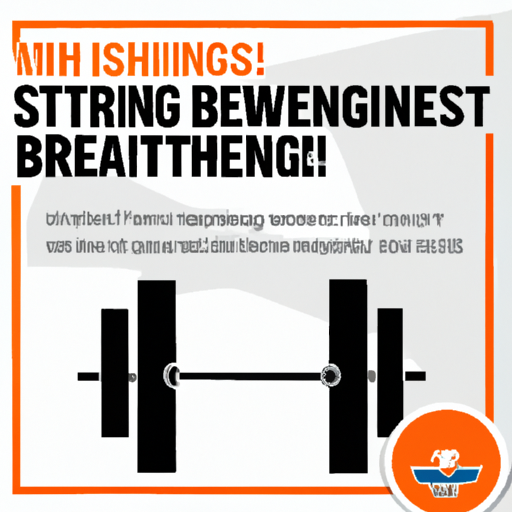
In today’s fast-paced world, it’s crucial to prioritize our health and well-being. With an increasing emphasis on fitness and strength, individuals are turning towards strength training as a means to achieve their goals. Whether you’re a complete beginner or someone looking to brush up on their skills, “Strength Training Basics: A Primer For Newbies” is the perfect resource to help you kickstart your fitness journey. This comprehensive guide provides a thorough introduction to the fundamentals of strength training, equipping you with the knowledge and techniques required to build a strong foundation. With step-by-step instructions and expert tips, this primer will empower you to confidently navigate through various exercises and maximize your workout potential. Embark on the path to a healthier and stronger you with “Strength Training Basics: A Primer For Newbies”.

More Information Here on Weight Loss
What is Strength Training?
Definition
Strength training, also known as resistance training, is a type of physical exercise that focuses on increasing muscle strength and endurance. It involves performing various exercises using external resistance, such as weights or resistance bands, to target specific muscle groups. The goal of strength training is to stimulate muscle growth, improve overall physical performance, and enhance functional abilities.
Benefits
Strength training offers a multitude of benefits for individuals of all fitness levels and ages. Firstly, it helps to increase muscle strength and power, which can have a significant impact on daily activities and sports performance. By enhancing muscular strength, strength training also improves joint stability and reduces the risk of injuries. Additionally, strength training aids in weight management by boosting metabolism and increasing calorie expenditure. It can also improve bone density and reduce the risk of osteoporosis, especially in older adults. Furthermore, strength training plays a crucial role in improving overall physical function and quality of life.
Common Misconceptions
There are several misconceptions surrounding strength training that often discourage individuals from incorporating it into their fitness routine. One common misconception is that strength training is only suitable for bodybuilders or those looking to bulk up. In reality, strength training can be adapted to suit a variety of goals, including muscle toning, fat loss, and overall fitness enhancement. Another misconception is that strength training is unsafe and can cause injuries. However, with proper technique and progression, strength training can be a safe and effective form of exercise. Lastly, many people believe that strength training is time-consuming. In reality, even short and focused strength training sessions can yield significant results.
Understanding Muscles
Types of Muscles
To understand how strength training works, it is essential to have a basic understanding of the different types of muscles in the body. There are three major types of muscles: skeletal muscles, cardiac muscles, and smooth muscles. Skeletal muscles are the ones we typically associate with movement and strength training. They are attached to our bones and enable voluntary movements such as walking, running, and lifting weights. Cardiac muscles are found in the heart and are responsible for pumping blood throughout the body. Smooth muscles, on the other hand, are found in the walls of organs, blood vessels, and the digestive system, and they facilitate involuntary movements.
How Muscles Grow
Muscles grow through a process called hypertrophy, which involves the enlargement of individual muscle fibers. When we engage in strength training exercises, the muscles undergo microscopic damage, causing the body to initiate a repair process. During this repair process, the body adapts by increasing the number and size of muscle fibers, resulting in muscle growth. This adaptation is largely driven by proper nutrition, including an adequate intake of protein, which provides the building blocks necessary for muscle repair and growth.
Importance of Muscular Strength
Muscular strength is crucial for performing everyday activities with ease and preventing injuries. Strong muscles help support the joints, improve posture, and enhance overall stability. By incorporating strength training into your fitness routine, you can improve your muscular strength, leading to improved functional abilities and better overall physical performance.
Types of Strength Training
Bodyweight Training
Bodyweight training is a form of strength training that utilizes the individual’s body weight as resistance. It includes exercises such as push-ups, squats, planks, and lunges. Bodyweight training is versatile, convenient, and accessible to individuals of all fitness levels.
Resistance Band Training
Resistance band training involves the use of elastic bands to provide resistance during exercises. These bands come in various levels of resistance, allowing individuals to gradually progress their strength training routine. Resistance band training is particularly beneficial for improving joint stability and flexibility.
Free Weights Training
Free weights training involves the use of dumbbells, barbells, kettlebells, or any other weights that are not attached to a machine. This form of strength training provides a greater range of motion and engages additional stabilizer muscles. Exercises such as squats, deadlifts, and bench press are commonly performed using free weights.
Machine-based Training
Machine-based training involves using exercise machines that specifically target certain muscle groups. These machines usually have adjustable weight stacks or resistance settings, allowing individuals to customize their workouts based on their strength level and fitness goals. Machine-based training is particularly helpful for beginners or individuals recovering from injuries.
Functional Training
Functional training focuses on improving movement patterns and enhancing overall physical performance for everyday activities. It involves exercises that mimic real-life movements, such as lifting, pushing, pulling, and twisting. Functional training can improve muscular strength, endurance, balance, and coordination.
CrossFit Training
CrossFit training is a high-intensity strength and conditioning program that combines elements of weightlifting, cardio, and gymnastics. It is known for its varied and challenging workouts, often performed in a group setting. CrossFit training aims to improve overall fitness, including strength, power, speed, endurance, and flexibility.
Powerlifting
Powerlifting is a sport that involves three main lifts: squat, bench press, and deadlift. Powerlifting focuses on maximal strength and requires individuals to lift as much weight as possible. It requires careful technique and often involves competing in structured competitions.
Olympic Weightlifting
Olympic weightlifting is another competitive strength sport that consists of two main lifts: the snatch and the clean and jerk. Olympic weightlifting focuses on explosive power, speed, and technique. It requires a high level of skill and is often seen in international sporting events such as the Olympics.

More Information Here on Weight Loss
Creating a Strength Training Program
Setting Goals
Before starting a strength training program, it is essential to establish clear and specific goals. Whether your goals are to gain muscle mass, enhance athletic performance, or improve overall fitness, having a clear vision can help guide your training and keep you motivated.
Choosing the Right Exercises
Selecting the appropriate exercises is vital in creating an effective strength training program. It is important to choose exercises that target multiple muscle groups and cover a range of movement patterns. Compound exercises, such as squats, deadlifts, and bench press, are particularly effective as they engage multiple joints and muscle groups simultaneously.
Determining Sets and Reps
Sets and reps refer to the number of times an exercise is performed in a workout. The number of sets and reps used in a strength training program depends on various factors, including individual fitness levels, goals, and preferences. Generally, beginners may start with 2-3 sets of 8-12 reps per exercise, while more advanced individuals may perform 3-4 sets of 6-8 reps or even lower for strength gains.
Rest and Recovery
Rest and recovery are crucial components of any strength training program. Allowing the body enough time to recover between workouts is essential for optimal muscle growth and injury prevention. It is recommended to have at least one rest day between strength training sessions and to prioritize quality sleep for proper recovery.
Tracking Progress
To monitor progress and ensure continuous improvement, it is important to track your strength training sessions. This can be done by keeping a workout journal or using smartphone apps that allow you to record the exercises, sets, reps, and weights used. Tracking progress allows you to identify areas of improvement and make necessary adjustments to your training program.
Importance of Proper Form
Maintaining proper form throughout each exercise is critical to maximize the benefits of strength training and minimize the risk of injuries. Performing exercises with incorrect technique not only reduces their effectiveness but can also lead to muscle imbalances and joint issues. It is essential to prioritize learning and practicing proper form with lighter weights before progressing to heavier loads.
Common Strength Training Exercises
Squats
Squats are one of the most fundamental strength training exercises, targeting the muscles of the lower body, including the quadriceps, hamstrings, and glutes. They also engage the core muscles for stability. Squats can be performed with bodyweight or with added resistance, such as a barbell or dumbbells.
Deadlifts
Deadlifts are a compound exercise that primarily targets the muscles of the lower back, glutes, hamstrings, and quadriceps. It also engages the core, upper back, and grip muscles. Deadlifts are performed by lifting a loaded barbell or dumbbells from the ground to a standing position while maintaining proper form and technique.
Bench Press
The bench press is an upper body exercise that primarily targets the chest muscles (pectorals), along with the shoulders and triceps. It is performed by lying on a bench and pushing a weighted barbell or dumbbells away from the chest until the arms are fully extended.
Shoulder Press
The shoulder press, also known as the military press, is a compound exercise that targets the deltoid muscles of the shoulders, as well as the triceps. It is performed by pressing a weighted barbell or dumbbells overhead from shoulder height.
Rows
Rowing exercises target the muscles of the upper back, including the latissimus dorsi, rhomboids, and traps. These exercises are performed by pulling or rowing a weight towards the body while maintaining proper posture and engaging the back muscles.
Lunges
Lunges are a unilateral lower body exercise that primarily targets the quadriceps, hamstrings, and glutes. They are performed by stepping forward or backward and descending into a lunge position, with the front knee bent at a 90-degree angle.
Pull-ups
Pull-ups are an excellent compound exercise for strengthening the muscles of the upper body, particularly the back and arms. They are performed by hanging from a bar and pulling the body up until the chin is above the bar.
Dips
Dips primarily target the triceps, along with the chest and shoulder muscles. They are performed by supporting the body with straight arms on parallel bars or other elevated surfaces and bending the elbows to lower the body until the upper arms are parallel to the floor.
Curls
Bicep curls are isolation exercises that specifically target the biceps muscles of the arms. They can be performed using dumbbells, barbells, or resistance bands by bending the elbows and curling the weight towards the shoulders.
Planks
Planks are an excellent core exercise that targets the abdominal muscles, along with the back and shoulders. They are performed by assuming a push-up position and holding the body in a straight line for a specific duration.
Developing Proper Technique
Starting with Light Weights
Regardless of your fitness level, it is crucial to start with light weights when learning new exercises or refining your technique. Starting with lighter weights allows you to focus on proper form and the mind-muscle connection, ensuring that you are engaging the correct muscles throughout the movement.
Engaging the Correct Muscles
Proper technique involves consciously engaging the target muscles during each exercise. This means focusing on the muscle group being worked and ensuring that other muscles are not compensating or taking over. Mindfully contracting and activating the target muscles can help maximize the effectiveness of each exercise.
Maintaining Correct Alignment
Maintaining correct alignment throughout each exercise is essential to ensure safety and effectiveness. This includes keeping a neutral spine, proper knee and hip alignment, and avoiding excessive joint stress. If you are unsure about proper alignment, consulting a fitness professional or trainer can be beneficial.
Breathing Techniques
Breathing plays a crucial role in strength training. It is important to inhale deeply before initiating a movement and exhale during the exertion phase. Proper breathing techniques help stabilize the core, maintain blood pressure, and ensure sufficient oxygen supply to the muscles.
Gradually Increasing Intensity
As you become more comfortable with an exercise, gradually increasing the intensity or resistance is essential for continued progress. This can be done by increasing the weight, adding more repetitions, or reducing rest periods between sets. However, it is important to progress gradually to avoid overexertion or injury.
Avoiding Common Mistakes
Overtraining
One common mistake in strength training is overtraining, which refers to excessive or insufficient recovery between workouts. Overtraining can lead to burnout, lack of progress, and an increased risk of injuries. It is crucial to listen to your body and allow for adequate rest and recovery between strength training sessions.
Neglecting Warm-ups and Cool-downs
Warming up before each strength training session is essential to prepare the muscles, joints, and cardiovascular system for exercise. It helps increase blood flow, improve flexibility, and reduce the risk of injuries. Similarly, cooling down with stretches and light cardio after a workout helps promote recovery and reduce muscle soreness.
Poor Nutrition
Nutrition plays a significant role in the effectiveness of strength training. Adequate protein intake is essential for muscle repair and growth. It is also important to consume a balanced diet that includes complex carbohydrates for energy and healthy fats for overall health and hormone regulation.
Ignoring Rest Days
Rest days are an integral part of any strength training program. Rest allows the body to recover and adapt to the stress of exercise, leading to muscle growth and strength gains. Ignoring rest days can lead to overtraining, increased risk of injury, and plateauing of progress. It is important to listen to your body and give it the rest it needs.
Lack of Consistency
Consistency is key in strength training. It is important to follow a regular training schedule and make strength training a part of your lifestyle. Skipping workouts or being inconsistent can hinder progress and make it difficult to achieve your fitness goals. Aim for a balanced and sustainable routine that can be maintained in the long run.
Safety Precautions
Warming Up Properly
Warming up properly before every strength training session is essential to prevent injuries. A warm-up should include dynamic stretches, light cardio exercises, and joint mobility exercises. This helps increase blood flow, warm up the muscles, and prepare the body for the upcoming workout.
Using Spotter/Supports
When performing exercises with heavy weights or at high intensities, having a spotter or using appropriate supports is important for safety. A spotter can provide assistance or take over if you struggle to complete a repetition. Supports, such as weightlifting belts or wrist wraps, can provide additional stability and support for certain exercises.
Listening to Your Body
Listening to your body’s signals is crucial in strength training. Pay attention to any pain, discomfort, or unusual sensations during exercises. If something feels off or causes pain, it is important to stop the exercise and seek guidance from a fitness professional or medical expert.
Modifying Exercises for Injuries
Individuals with pre-existing injuries or underlying medical conditions may need to modify or avoid certain exercises. It is important to consult with a healthcare professional or a qualified fitness trainer to determine the appropriate modifications or alternative exercises that can be safely performed.
Consulting with a Professional
For those new to strength training or anyone looking to refine their technique, seeking guidance from a qualified fitness professional can be extremely beneficial. A personal trainer can help assess your fitness level, set realistic goals, design a customized training program, and provide ongoing support and guidance.
Tips for Beginner Strength Trainers
Starting with Light Weights
As a beginner, it is important to start with light weights to allow your body to adapt to the new demands of strength training. Focus on mastering proper form and technique before gradually increasing the weight or intensity.
Focusing on Proper Form
Proper form and technique are essential in strength training to maximize results and reduce the risk of injuries. Take the time to learn and practice each exercise correctly before progressing to heavier weights or more challenging variations.
Gradually Progressing
As your strength and fitness levels improve, gradually increasing the intensity and difficulty of your workouts is important for continued progress. This can be done by adding more weight, increasing the number of repetitions, or trying more advanced variations of exercises.
Seeking Guidance from a Trainer
Working with a qualified personal trainer, especially in the beginning stages, can provide you with the necessary knowledge, guidance, and motivation to kickstart your strength training journey. A trainer can help design a personalized program, teach proper form, and ensure that you are progressing safely and effectively.
Staying Motivated
Strength training can sometimes feel challenging and demanding, especially in the beginning. Setting realistic goals, tracking progress, and celebrating milestones can help keep you motivated along the way. Find a workout buddy or join a supportive community to stay accountable and inspired.
Conclusion
Strength training is a powerful and effective way to improve muscular strength, endurance, and overall fitness. By understanding the basics of strength training and incorporating it into your fitness routine, you can experience numerous benefits, including increased muscle tone, improved functional abilities, enhanced athletic performance, and better overall health. Remember to always prioritize safety, proper form, and gradual progression to make the most out of your strength training journey.
